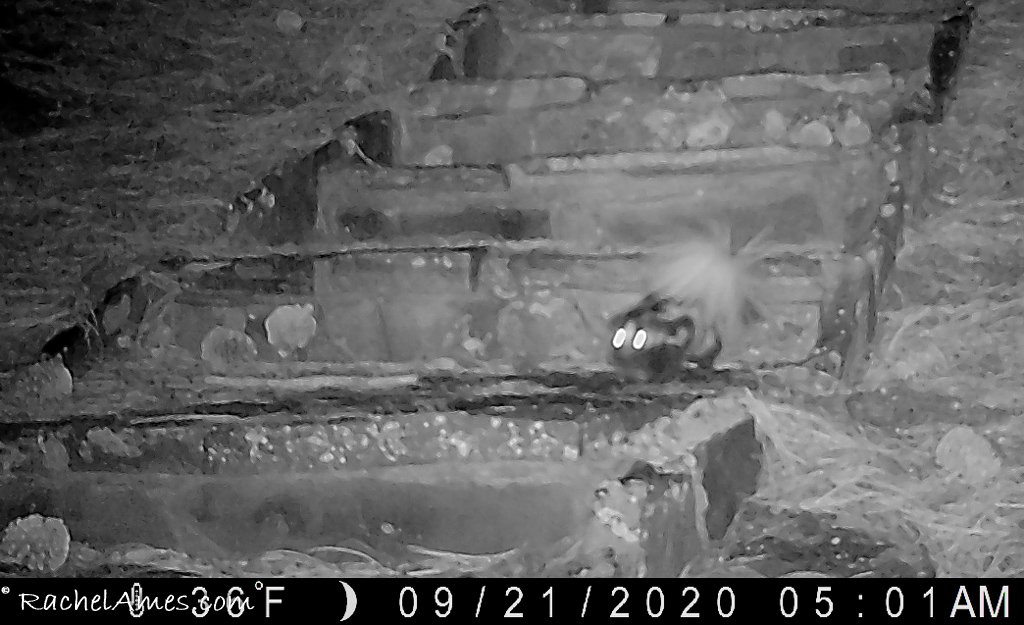Wildlife Wednesday -- Bear Hyperphagia
If it seems like bears have been more active lately, it is not your imagination. Bears are now in a state of hyperphagia, meaning they have an insatiable hunger. Since bears can lose up to 30% of their body weight during hibernation they must gain all this back before winter. For example, a 150 pound bear going into hibernation may come out of hibernation at only 100 pounds. That means he/she must gain back 50 pounds before going into hibernation again. Additionally, that weight must be all fat. Bears use water from the metabolization of fat to stay hydrated.
Wildlife Wednesday — Northern Saw-whet Owl
On a recent run I paused at a curve in the trail to look for a favorite Pine squirrel. Looking down, I noticed two bright yellow eyes staring back at me. Although I had never seen one in person before, I quickly recognized it as a Saw-whet owl. I have heard their “too, too, too” calls before at night, so I knew they were Estes Valley residents.
from the archives: Feathered Friday - The male broad-tailed hummingbird
Nothing says summer in the Rocky Mountains like the buzz of the male broad-tailed hummingbird.
Wildlife Wednesday — Lazuli Buntings
It seems like Lazuli Buntings have been a little more common this year. These beautiful birds have a finch-like appearance but are more closely related to cardinals and grosbeaks. Males feature a distinctive blue with white belly, orange chest and black mask. Females are a more subdued light brown with a slight blue tinge and pale chest and wing bars. Lazuli Buntings thrive in burnt areas as well as shrubby hillsides and along streams. They forage in the understory looking for caterpillars, ants, beetles, and other bugs as well as berries and seeds.
Wildlife Wednesday — BlazingStar
Last week we celebrated National Moth Week with a look at the day-active Police Car moth. This week we look at a flower that evolved with night flying moths in mind. During the day Smoothstem Blazingstar, Mentzelia laevicaulis, is easy to ignore with its long jagged leaves reminiscent of a thistle. This Blazingstar is also known as Stickleaf due to the stiff hairs on the leaves that give them a rough texture that can easily stick to clothes.
Wildlife Wednesday — Police Car Moth
The last full week of July marks National Moth Week. Most moths are nocturnal. We often see them fluttering around lights at night. (Many moths use far off light source such as the moon to orient flight at night. When a moth encounters a close light source such as a porch light they can become confused and fly erratically). Members of the tiger moth family are diurnal, however, and can be seen feeding during the day.
Wildlife Wednesday -- Slime Mold
Have you ever noticed a suspicious white blob on the side of tree? This is an organism that moves through the environment, but isn’t an animal. It has the ability to learn, but has no brain. It detects light, but has no eyes. Despite its name it is not a fungus or plant. This is a reticularia lycoperdon, or the “False Puffball” slime mold. Slime molds are interesting organisms that don’t fall into the animal, plant, or fungi classification. Most slime molds are microscopic so cannot be seen by the naked eye. False Puffballs, however, belong to the Plasmodail slime molds which can be quite large.
Wildlife Wednesday — Fartlek
Fartlek is a Swiss term for “speed play”. Many runners use fartlek training to help improve not only speed, but also strength, agility, efficiency, and endurance. Fartkeks can take many forms from recess on the school yard to segments of fast paced running based on time or distance. It can be regimented or totally free form. In the animal world you may see this with a pack of coyotes, or elk calves — both social animals, chasing and playing together.
For deer, fartleks are especially important and take a more regimented or constrained form.
Wildlife Wednesday — Least Chipmunks
Last week we were treated to the sight of a baby Least chipmunk making its first excursion from its natal den. At first it looked a little stunned as it sat motionless on a post. Perhaps it was the bright sunlight or maybe the discovery of a whole new world.
Furry Friday — Mother Elk
It seems like elk have been in the news a lot lately with 3 attacks by cow elk here in Estes in the last week. While this is an unusual number, these elk are displaying normal behavior.
Wildlife Wednesday — 8.5 months
Think back to what you were doing about 8 1/2 months ago. Maybe spending the evening watching the elk rut in Moraine Park? Or maybe a month later you were watching the Mule deer bucks chasing does. Now we see the fruits of their labor with new calves and fawns.
Wildlife Wednesday -- Celebrating Motherhood
This week we celebrate motherhood. Motherhood takes on many different forms and requirements depending on the needs of the young. For some, like the frog or salamander, the mother’s job is done once she lays her eggs. For others, like the Terrestrial garter snake, the mother’s duty goes one step further by retaining her eggs in her body. Once hatched, her young are on their own. For most others, however, motherhood is much more of an investment.
Wildlife Wednesday -- Thatching Ants
If you have been out in the meadows and valleys lately you may have noticed an increase in ant activity, particularly the Western Thatching ant. These ants create mounds covered with twigs, or thatch. The nest often starts at the base of a sage brush, wax currant, or similar plant. The ants then chew away the bark and spray formic acid onto the plant until it dies. The plant is then removed allowing a central passage down into the nest. Pretty clever!
Wildlife Wednesday -- Hibernation Zone
First came the chipmunks and then the Wyoming ground Squirrels. More recently, marmots and Golden-mantled ground squirrels have emerged from hibernation. Rodents are known for their ever growing incisors, or front teeth. Throughout their lives dentin is added on a circadian, or daily, basis to the root of the tooth. These teeth are kept in check by the wear of chewing.
Wildlife Wednesday -- Western Spotted Skunk
A big thanks to Robert Yone for sharing his Western Spotted Skunk photos last week. (As well as his previous photos and video from last fall). Both Western Spotted skunks and the more common Striped Skunks are rare sightings since they are highly nocturnal creatures. Both species are carnivores preying on insects, worms, grubs, small mammals such as voles, mice, and ground squirrels, reptiles and amphibians, as well as birds and bird eggs. Both will eat vegetable matter such as fruits and berries as well. Aside from their markings, there are several differences between the two species.
Wildlife Wednesday - Signs of Spring
I missed the big snow in the Estes Valley last week but got to observe some interesting insect activity down in the Front Range. Recent warm temperatures and plenty of moisture have provided an early glimpse of spring.
Wildlife Wednesday. - Bluebirds in the Estes Valley
Mountain Bluebirds are one of our first migratory birds to make their way back to the Estes Valley. We often see them perched on a bush or fence scanning the ground and then dropping down to catch a bug. How do they survive heavy spring snows like we are about to receive? Bluebirds are omnivorous so can switch their diet from bugs to fruit when needed. In March in the Estes Valley that may mean feeding on juniper, mistletoe, or currants. Prolonged periods of winter weather can be hard on all of us. Fortunately, late season storms usually don’t last long so warmer days shouldn’t be far away. In the next week or two, we should be seeing the first western bluebirds in the area, too.
Wildlife Wednesday — striped skunk
Spring is in the air. Bluebirds have returned. Deer have lost their antlers and elk are starting to shed theirs. Chipmunks are out and starting to establish territories and skunks are starting to become more active as well. Unlike chipmunks, skunks do not hibernate but greatly reduce their feeding and activity level during the winter. Skunks spend much of the winter bedded down in a den, usually an abandoned burrow of another animal. A couple times a day they may get up to move around for a few minutes but otherwise the winter is spent conserving energy.
Wildlife Wednesday — Anatomy of a Red fox track
Foxes are one of those animals that we rarely see but the tracks they leave behind alert us to their presence. Red fox tracks can be confused with those of coyotes. Both are similar shape and size, although the fox’s tend to be a little smaller. Red foxes’ tracks tend to be less than 2” across, coyotes’ a little over.
Wildlife Wednesday - Ptarmigan in Winter
High up in the upper reaches of the Estes valley watershed lives a bird perfectly adapted to the alpine conditions — the White-tailed Ptarmigan. In fact, the White-tailed Ptarmigan is the only bird that spends its entire life at tree line or above. It is so well adapted to the winter that it actually gains weight during these cold months!




















